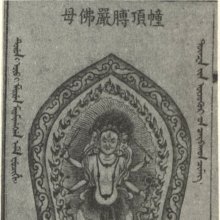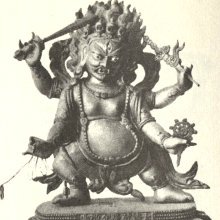Dhvajagrakeyura, Dhvajāgrakeyūra, Dhvajāgrakeyūrā: 8 definitions
Introduction:
Dhvajagrakeyura means something in Buddhism, Pali, Hinduism, Sanskrit. If you want to know the exact meaning, history, etymology or English translation of this term then check out the descriptions on this page. Add your comment or reference to a book if you want to contribute to this summary article.
Images (photo gallery)
In Buddhism
Tibetan Buddhism (Vajrayana or tantric Buddhism)
Source: Wisdom Library: Tibetan BuddhismDhvajāgrakeyūrā (ध्वजाग्रकेयूरा) is the name of a Dhāraṇī Goddesses mentioned as attending the teachings in the 6th century Mañjuśrīmūlakalpa: one of the largest Kriyā Tantras devoted to Mañjuśrī (the Bodhisattva of wisdom) representing an encyclopedia of knowledge primarily concerned with ritualistic elements in Buddhism. The teachings in this text originate from Mañjuśrī and were taught to and by Buddha Śākyamuni in the presence of a large audience (including Dhvajāgrakeyūrā).
Source: archive.org: The Indian Buddhist IconographyDhvajāgrakeyūrā (ध्वजाग्रकेयूरा) refers to one of the female emanations of Akṣobhya, as mentioned in the 5th-century Sādhanamālā (a collection of sādhana texts that contain detailed instructions for rituals).—Two Sādhanas in the Sādhanamālā describe two widely different forms of Dhvajāgrakeyūrā. In one the effigy of Akṣobhya on the crown is expressly mentioned, but in the other, the Dhyāni Buddha is absent. [...]
Dhvajāgrakeyūrā (first variety, three-faced with four arms).—[Her Colour is blue; her Appearance is terrible; her Āsana is the pratyālīḍha].—The Dhyāna (meditation instructions) in the Sādhanamālā is as follows:—
“Dhvajāgrakeyūrā is blue in colour, three-faced, and four-armed, with the right and left faces of red and green colour (respectively). She carries the sword and the noose in the two right hands, and the khaṭvāṅga stamped with a vajra and the cakra in the two left, has brown hair rising upwards on her head which is embellished by arow of five shrivelled heads. She wears garments of tiger-skin, and has faces distorted with bare fangs. She has a protruding belly, stands in the pratyālīḍha attitude, has her seat on and glows like the sun, wears yellow garments and jacket, originates from the syllable “Hūṃ” and bears the image of Akṣobhya on the crown”
Dhvajāgrakeyūrā (first variety, four-faced with four arms).—[Her Colour is yellow].—
[As already pointed out, Dhvajāgrakeyūrā has another form, with four faces and four arms carrying the sword and the cakra in the two right hands, and the tarjanīpāśa and the mūṣala, marked with a vajra, in the two left. A triśūla hangs from her left shoulder. Her first face is yellow, left red, right white, and the face above is distorted and is of the colour of smoke. In all other respects her form is identical with the one described above.]

Tibetan Buddhism includes schools such as Nyingma, Kadampa, Kagyu and Gelug. Their primary canon of literature is divided in two broad categories: The Kangyur, which consists of Buddha’s words, and the Tengyur, which includes commentaries from various sources. Esotericism and tantra techniques (vajrayāna) are collected indepently.
Mahayana (major branch of Buddhism)
Source: academia.edu: A Study and Translation of the GaganagañjaparipṛcchāDhvajāgrakeyūra (ध्वजाग्रकेयूर) refers to “(the concentration called) a ring on the top of a standard”, according to the Gaganagañjaparipṛcchā: the eighth chapter of the Mahāsaṃnipāta (a collection of Mahāyāna Buddhist Sūtras).—Accordingly, as Bodhisattva Gaganagañja explains to Bodhisattva Ratnaśrī what kind of concentration should be purified: “[...] (19) [when the Bodhisattvas attain] the concentration called ‘Splendor of light’, all Buddha-fields will appear. (20) [when the Bodhisattvas attain] the concentration called ‘Performing duties’, attachment and anger will be eliminated; (21) [when the Bodhisattvas attain] the concentration called ‘Ring on the top of a standard’ (dhvajāgrakeyūra-samādhi), all qualities of the Buddhas will appear; [...]”.
Source: Brill: Śaivism and the Tantric Traditions (mahayana)Dhvajāgrakeyūra (ध्वजाग्रकेयूर) or Dhvajāgrakeyūradhāraṇī is the name of an ancient text dealing with Dhāraṇī (rites for the protection of the state).—The setting of this scripture is the celestial Trāyastriṃśat abode where Śakra requests help from the Buddha after the gods have been defeated by the Asuras, led by Vemacitrin. [...]

Mahayana (महायान, mahāyāna) is a major branch of Buddhism focusing on the path of a Bodhisattva (spiritual aspirants/ enlightened beings). Extant literature is vast and primarely composed in the Sanskrit language. There are many sūtras of which some of the earliest are the various Prajñāpāramitā sūtras.
Languages of India and abroad
Sanskrit dictionary
Source: Cologne Digital Sanskrit Dictionaries: Edgerton Buddhist Hybrid Sanskrit DictionaryDhvajāgrakeyūra (ध्वजाग्रकेयूर).—(1) m., name of a samādhi: Saddharmapuṇḍarīka 424.1; Mahāvyutpatti 530 (not in Śatasāhasrikā-prajñāpāramitā); (2) name of a work: Mahāvyutpatti 1410 (compare Dhvajāgrasūtra).
--- OR ---
Dhvajāgrakeyūrā (ध्वजाग्रकेयूरा).—name of a goddess: Sādhanamālā 403.1 etc.
Source: Cologne Digital Sanskrit Dictionaries: Monier-Williams Sanskrit-English DictionaryDhvajāgrakeyūra (ध्वजाग्रकेयूर):—[=dhvajāgra-keyūra] [from dhvajāgra > dhvaja > dhvañj] m. ‘the ring on the top of a standard’, Name of a [particular] Samādhi, [Buddhist literature]
[Sanskrit to German]
Sanskrit, also spelled संस्कृतम् (saṃskṛtam), is an ancient language of India commonly seen as the grandmother of the Indo-European language family (even English!). Closely allied with Prakrit and Pali, Sanskrit is more exhaustive in both grammar and terms and has the most extensive collection of literature in the world, greatly surpassing its sister-languages Greek and Latin.
See also (Relevant definitions)
Partial matches: Keyura, Dhvajagra.
Starts with: Dhvajagrakeyuradharani.
Full-text: Keyura, Dhvajagrasutra, Dhvajagra.
Relevant text
Search found 2 books and stories containing Dhvajagrakeyura, Dhvajāgrakeyūra, Dhvajāgra-keyūrā, Dhvajāgrakeyūrā, Dhvajagra-keyura, Dhvajāgra-keyūra; (plurals include: Dhvajagrakeyuras, Dhvajāgrakeyūras, keyūrās, Dhvajāgrakeyūrās, keyuras, keyūras). You can also click to the full overview containing English textual excerpts. Below are direct links for the most relevant articles:
The Indian Buddhist Iconography (by Benoytosh Bhattachacharyya)
A Dictionary Of Chinese Buddhist Terms (by William Edward Soothill)
Related products
.jpg)

